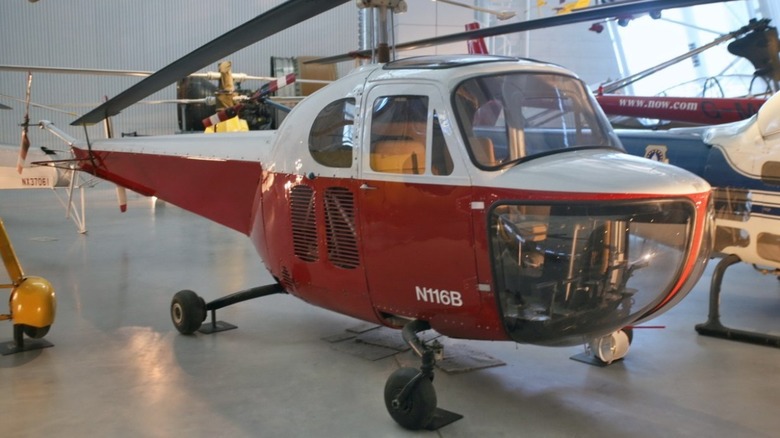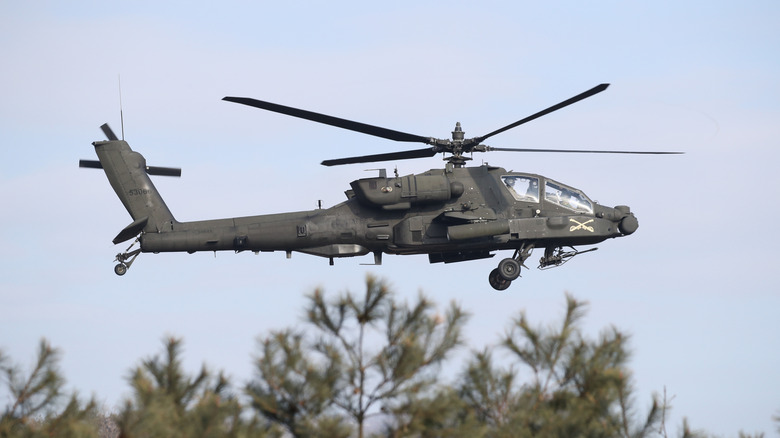How Long Can A Helicopter Hover In Place? (And What Is The Record?)
To fly or be flown in a helicopter is a very different experience to traveling by airplane, even if a rare helicopter-plane hybrid does exist. As pilot Nancy Bradshaw explained to Helipaddy in August 2021, "flying helicopters ... is more about your 'actual flying' skills. There is far more stick and rudder action and a lot less automation." It may be an intimidating notion, and helicopters can be notoriously difficult to tame, but this level of complete manual control allows pilots to perform maneuvers that are beyond the capability of (almost) any airplane. Primarily, helicopters, such as the iconic Black Hawk, can hover.
This capability is vital when performing rescues from the air, when carefully and steadily descending to land, and in a range of other scenarios — both routine or otherwise — that a chopper pilot may face. Their trusty aircraft itself, meanwhile, is designed to be able to perform and maintain this feat, but the length of time for which it can hover in place is highly variable. The National Police Air Service of England and Wales notes that "Each helicopter has a maximum endurance of approx two hours," in terms of staying in the air overall, and that "hovering on a hot summer day will take more fuel than slow orbits."
The size and weight of the helicopter, its fuel level, and the current weather conditions will all influence how long it can safely hover for at any given moment, but the current record hover was achieved in December of 1989. According to Guinness World Records: a Bell 47B continuously hovered for an astonishing 50 hours and 50 seconds.
Achieving this astonishing 50-hour hovering record
To achieve a hover of just over 50 hours, you might expect that only a model at the pinnacle of technology (for 1989) would do. Interestingly, though, the Bell 47B used by Douglas Daigle, Dave Mayer, Brian Watts, and Rod Anderson to claim the record was far from a spring chicken. In fact, it was Bell's very first helicopter model to be commercially produced, introduced in 1946.
Specs-wise, it doesn't seem the most powerful model around, with a 200 horsepower Franklin 6V4-200-C32 offering a top speed of approximately 94 mph. Nonetheless, it achieved a feat that still hasn't been topped by any other model, decades later. The Los Angeles Times reported at the time that the four men chose the illustrious setting of Anaheim Stadium's parking lot to attempt to beat the previous record (which stood at 47 hours), and did so in consummate style. Contest and Records Board of the National Aeronautics Association chairman, Chuck Tibbetts, marveled, "to hover a helicopter for 50 hours, changing crews, takes a lot of proficiency. Especially with an old bird like the one they used."
A very high-tech method was used to make certain that no illicit contact with the ground had invalidated the record at any point: Eggs fixed to the wheels of the hard-working Bell 47B. "The chopper ... landed so the eggs broke into four frying pans at 4:41:05 p.m. Friday," the newspaper reported. "At the same time, eight private helicopters flew overhead in a congratulatory convoy."
How helicopters hover
Hovering is typically not a position in the sky that pilots can simply set for the aircraft to maintain. Though there are limited autopilot solutions for helicopter pilots, such as that offered by UAV Navigation, keeping a helicopter in a hovering state typically requires precise and constant balancing of the controls. Helicopter Pro Flight Training explains that it's only through careful management of the cyclic controls that the pilot can prevent external forces from pulling the helicopter out of the position it's trying to keep. At the same time, the collective controls are vital to resisting gravity's insistence on bringing the chopper back to terra firma, as it's through these that the pilot can tweak the positioning of the rotors, and so the amount of lift they have to work with.
The essential factor in keeping equilibrium, whether you're piloting a full-size helicopter or even battling to keep control of a remote controlled one, is being delicate. As Kenny Keller of Helicopter Online Ground School LLC puts it, "everybody that learns to fly a helicopter, and learns to hover a helicopter, has trouble in the beginning with over-controlling." Keller goes on to clarify, "the key is, you have to remember: smooth control inputs."
It's a matter of developing experience and confidence. Hovering for over 50 hours isn't beyond the capabilities of a post-World War II era helicopter, if it has the fuel supply and the pilots have the technical skill to keep it in place in the air. This feat is a very extreme case indeed, though: A fully-laden AH-64 Apache, for instance, can stay in the air for approximately 2.5 hours. Some military helicopters can remain airborne for longer without refueling, however.


